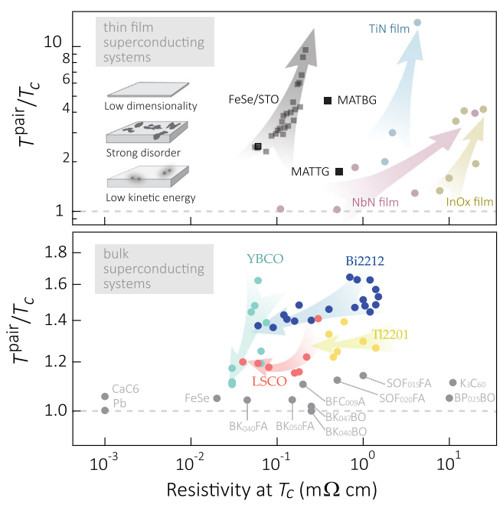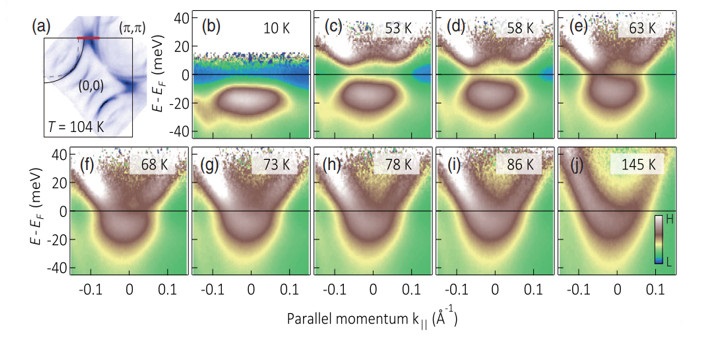Since the groundbreaking discovery of copper oxide (cuprate) high-temperature superconductors in 1986, the quest to raise the superconducting transition temperature (Tc) in these systems never stopped. However, since the realization of the 135K Tc in Hg-containing cuprates in 1993, the record has remained off-limits to ensuing efforts under ambient conditions. Understanding the mechanisms that limit the superconducting Tc in cuprates has become an imperative task in order to effectively engineer Tc. Typically in a superconductor, its electrons need to “pair up” in doublets (so-called Cooper pairs) to attain superconducting properties. In most superconductors, the interaction that binds two electrons together (known as the “pairing glue”) dictates Tc, above which the glue strength would vanish.

However, over the past three decades, scientists have found that the cuprate superconductors - especially when their Tc’s are maximized with respect to a varying carrier density - seem to defy this conventional wisdom. The superconducting pairing glue seems to survive up to a temperature substantially higher than Tc, meaning there might be more unexploited potential to increase Tc. This phenomenon, called fluctuating superconductivity, is often associated with either low system dimension, low carrier density, or strong spatial disorder. Figure 1 shows how superconducting fluctuations vary to different degrees in some ~15 archetypal superconducting systems, depending on the above contributing factors. Once summarized in this way, besides having the highest ambient pressure Tc, the cuprate superconductors stand out as a bulk superconducting system with the largest superconducting fluctuations - i.e. highest “unreleased” potential for further Tc enhancement. However, before one can targetedly unleash this potential, we need to understand: why are heavily hole-doped cuprates still having such strong fluctuations, despite having a high carrier density, being nearly three dimensional, and not universally disordered? Are these fluctuations of a superconducting nature after all?
To mount a coordinated attack on this problem uniquely defined at the junction of electronic structures and thermodynamics, the researchers resort to the high resolution angle-resolved photoemission spectroscopy (ARPES) station at SSRL BL5-4, and high precision thermodynamic probes at UC Berkeley and Karlsruhe Institute of Technology. First, to understand the nature of this fluctuation, one can look at a spectroscopic hallmark for the superconducting energy gap - particle-hole symmetry. This symmetry is defined as the symmetric quasiparticle energy-momentum dispersion around the Fermi level (EF) when Cooper pairs are present. It is often considered extremely challenging to see in ARPES the states above EF due to the exponentially suppressed electron population following the Fermi statistics. However, with remarkably stable chamber conditions, and the high resolution and statistics at BL5, the researchers could recover the coveted upper branch of the quasiparticle dispersion in this study. Even better, the full temperature dependent evolution of this feature could be traced out as the system enters the fluctuating superconducting state above Tc = 66 K (Figure 2). This is the first time that particle-hole symmetry is directly observed in these fluctuating states, unambiguously confirming its superconducting nature.

The next question is, if the superconducting pairing glue is not the deciding factor of Tc, what is it? Here in this work, the researchers also discovered a surprising connection between the development of the superconducting phase coherence - phenomenologically indicated by a sudden sharpening of the superconducting quasiparticle peak - and the thermodynamic singularity at Tc revealed in heat capacity and lattice expansivity measurements. This underlines the importance of phase ordering in dictating the superconducting Tc even in the high carrier density regime in cuprates.
The last question is, what can be a possible cause for such strong phase fluctuations in this supposedly rather metallic system? From the high resolution ARPES derived electronic structure, the researchers further reveal that despite the total carrier density being high in such systems, the superconducting electrons predominantly come from a momentum region with partially flat bands, where the “effective mass” is more than ten times heavier than the rest. This provides a basis for weakly linked phases between Cooper pairs, in a way similar to low electron density systems. Indeed, with the help of a state-of-the-art numerical calculation, the researchers found that the existence of such “flat bands” - even if only partially flat in the momentum space - can readily suppress the phase coherence, and amplify the phase fluctuations caused by even a small amount of disorder. This striking mechanistic discovery can be applied to superconducting systems beyond the current cuprate superconductors, such as the novel flatband superconducting magic-angle twisted graphene systems.
In summary, enabled by the high resolution ARPES station at BL5, this work confirms the superconducting nature of substantial fluctuations in heavily carrier doped cuprate high-Tc superconductors, demonstrates an empirical way to detect phase coherence in the spectral function, and uncovers a long overlooked mechanism - partially flat bands - to modulate the superconducting phase coherence. These concerted efforts point to a clear practical path to engineer the phase degree of freedom, and unleash the full superconducting potential in cuprate high-Tc superconductors.
Y. He, S.-D. Chen, Z.-X. Li, D. Zhao, D. Song, Y. Yoshida, H. Eisaki, T. Wu, X.-H. Chen, D.-H. Lu, C. Meingast, T. P. Devereaux, R. J. Birgeneau, M. Hashimoto, D.-H. Lee and Z.-X. Shen, "Superconducting Fluctuations in Overdoped Bi2Sr2CaCu2O8+δ", Phys. Rev. X 11, 031068 (2021) doi: 10.1103/PhysRevX.11.031068




